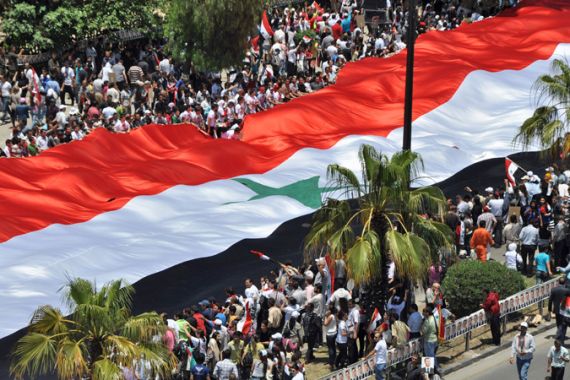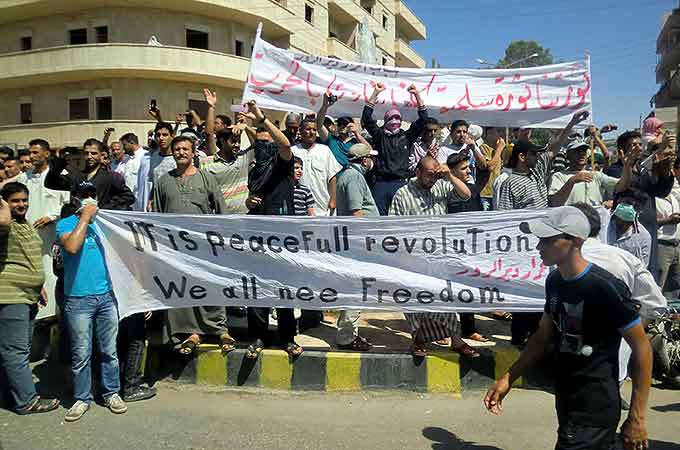Aleppo: Syria’s sleeping giant stirs
As the uprising enters its fourth month, Syria’s second city is becoming increasingly unsettled.

 |
| The streets in towns and cities across Syria have been filled with demonstrators every Friday since mid-March [AFP] |
On the surface, all seems calm in Syria’s second city.
Traffic and tourists might not be bustling along Aleppo’s ancient thoroughfares in the abundance they once did, but to a casual observer there appears little sign that the turmoil of Syria’s four-month old uprising has made much of an impact on its largest city.
But talk to shopkeepers, hotel managers and traders in Aleppo’s famous covered souk and one soon finds grumblings of dissent.
For in the Syrian capital of commerce, no one is making money anymore, threatening to undermine the key pillar of a long established pact between Aleppo’s Sunni merchant class and the imposed stability of the Alawite-led regime.
“Where are you, Halab?” chanted thousands of protestors, using the city’s Arabic name, exasperated by Aleppo’s conspicuous quiet while streets in towns and cities across the country filled with demonstrators every Friday since mid-March.
The answer is an interlocking mix of political, religious and economic interests which the regime has been largely successful in co-opting and which have kept Aleppo quiet, but which appear, as the uprising enters its fourth month, to be coming increasingly unstuck, threatening what analysts describe as the regime’s Achilles heel.
“If Aleppo were to rise up, it would mean that one of the metrics by which the West is charting the fall of the Assad regime would have been met,” said Andrew Tabler, a Syria expert at the Washington Institute for Near East Policy.
A student at Aleppo University was beaten to death by security forces during a pro-democracy demonstration on June 17, activists said – the first death of a protester there since the uprising began and a grim example of the length the regime will go to impose its stability on the country’s largest city.
Mohammed el-Ektaa was among a small group of students who held protests on the university campus before being attacked by secret police and pro-Assad thugs, known as shabiha, said a member of the Syrian
Revolution Co-ordinators’ Union (SRCU), an activist network in the city.
Mohammed’s body was returned to his family by secret police shortly after the attack. Another student was also beaten and arrested during the protests, said the SRCU, while secret police broke into student dormitories making arbitrary arrests. The SRCU member said he had seen one student jump from his third floor room to avoid being arrested.
Students have been at the vanguard of attempts to bring Syria’s nationwide protests against the Assad family’s 41-year-dictatorship to Aleppo, a city of some four million, one of the largest in the Levant.
‘Security touring the mosques’
Though predominantly Sunni Muslim, increasingly religiously conservative and – during the bloodiest days of Iraq’s civil war – a producer of the murky jihadist preacher known as Abu Qaqa, who called for the slaughter of Americans in Iraq, Aleppo’s mosques have long been controlled by the secret police of the Alawite-led regime, an offshoot of Shia Islam.
Since its military crushed an armed rebellion in Aleppo led by the Muslim Brotherhood in 1980, the regime uses the state-run ministry of religious endowments to appoint Aleppo’s preachers, ensuring worshippers at Friday prayers never again hear the call to turn against their own rulers.
Though an advocate of violent jihad in the name of Islam, Abu Qaqa, a Kurd, was allowed to preach in his Aleppo mosque unhindered by the secret police, until he was gunned down in September 2007 after reports surfaced he had delivered a list of Sunni extremists to state intelligence.
Today, however, the murky relationship between the regime and Aleppo’s preachers is being challenged by a message less easily drowned out in violence.
“The people are becoming angrier every week and the government is not giving much, just some promises. Every Friday I feel some worshippers want to demonstrate but I call on them to be quiet,” said a prominent Muslim scholar who preaches at one of Aleppo’s largest mosques, asking to remain anonymous fearing regime reprisals.
“To see hundreds of students demonstrating, even if they are small demonstrations, is symbolic: They are the young and educated. Some sheikhs [preachers] told me they cannot control their people any more and security men are touring around the mosques every Friday. It’s only a matter of weeks and Aleppo will see big demonstrations.”
A second, even more significant pillar of the regime’s control over Aleppo now also appears to be beginning to crumble as well: the economy.
Sitting at the end of the Silk Road, the ancient trading route between Asia and the Mediterranean, Aleppo is one of the oldest centres of commerce in the world.
Specialising in textiles and industry, modern Aleppo’s economy is largely shaped by its access to, and competition with, the vast market of Turkey, just 50km north.
Flood of Turkish imports
For decades Aleppo’s original Sunnis merchant families did very well trading with their co-religionists in Turkey while maintaining stability in the city as part of a deal with the Alawite-led regime of Damascus.
But from 2004, Aleppo’s industries have been hit hard by a flood of imports from Turkey following a free-trade agreement between the two nations, built on Bashar al-Assad’s personal friendship with Recep Tayyip Erdogan, the Turkish prime minister.
Today, however, Erdogan accuses President Assad’s regime of “savagery” against its own people, leading regional calls for the regime to end its brutal crackdown.
“The regime has bribed a lot of Sunni business interests, leaving them to do business while being protected by the security apparatus,” said Imad Salamey, assistant professor of political science at the Lebanese American University (LAU) and an expert on Syrian affairs.
“But eventually the bourgeois will come to feel the regime can no longer provide them with economic stability and that business as usual is no longer viable. They will no longer feel committed to the existing system. I think it’s a matter of time.”
In a speech at Damascus University on June 20, Assad acknowledged that the greatest challenge facing his regime as it attempts to crush the uprising “is the weakness or collapse of the Syrian economy.”
“Aleppo was one of the areas that suffered extensively from the regime’s bloody crackdown on the Muslim Brotherhood, so the fear factor still remains,” Tabler, of the Washington Institute for Near East Policy, said.
“When added to the interests of the city’s merchants and traders, it’s not surprising protestors have not come out in force. But as the protests have moved into Aleppo’s hinterland, this will put the fear factor to the test.”
As well as protests in Aleppo University, June 17 also saw pro-democracy protests in the Aleppo neighbourhoods of Salahedeen and Seif al-Dawali. It was the second Friday of protests in Seif al-Dawali.
“Although it is slowly, it is very important to see Aleppo joining the uprising,” an opposition leader in the city said.
In the villages north of Aleppo, a witness estimated around 5,000 protesters had turned out across Tal Rifaat, Hreitan, Mareaa and Aazaz. In Hreitan protesters called on local residents to join them in the streets, chanting: “The one who not participate has no conscience.”
A week before, on June 10, the first protests had spread from Hreitan, 10km north of Aleppo, to Akhtareen, 13km northeast of the city, where several thousand gathered to call for freedom and support Jisr al-Shughour, which is less than 100km west of Aleppo.
Massive layoffs imminent
Sitting behind his desk in a lavishly decorated office, a photograph of President Assad hanging on the wall, a 45-year-old Sunni businessman from Aleppo’s Old City cautioned that the economic consequences of the crisis in Syria could soon fuel further protests.
“Today I am losing money as no one wants to buy garments and textile. Syrians are buying bread and food stuffs as they are worried about the future. I am seriously considering having to sack or give unpaid vacation to a third of my workforce,” he said.
Late last month Assad had met a delegation of Aleppo business leaders, said the textile factory owner. The businessmen had urged Assad to end the crisis in Syria swiftly to avoid massive layoffs.
“The government promised to decrease fuel and electricity prices, but this is not enough for us,” said the textile factory owner.
“The government looks to us as their partners who should help them in this crisis. But if the situation continues, Aleppo will feel the economic consequences and we will see demonstrations in the city.”
In April, the International Monetary Fund lowered Syria’s economic growth rate this year from 5.5 per cent to three per cent. The International Institute of Finance, an association of major global banks, paints an even bleaker picture, projecting Syria’s GDP could contract by as much as three per cent in fiscal 2011.
Finally, the political pact that kept Aleppo, and much of Syria’s population, bound to the regime for decades appears also to be coming unstuck in the demands and protests of the students who have led the opposition in the city.
Abdul Qader, 22, a student at Aleppo University’s Faculty of Arts is one of those.
“During the last four decades, the Baathists were telling us that the government gives us, the citizens, everything for free or with a subsidised price and for that reason we should be silent,” he said. “But now we get no free services and no bread so we want freedom.”